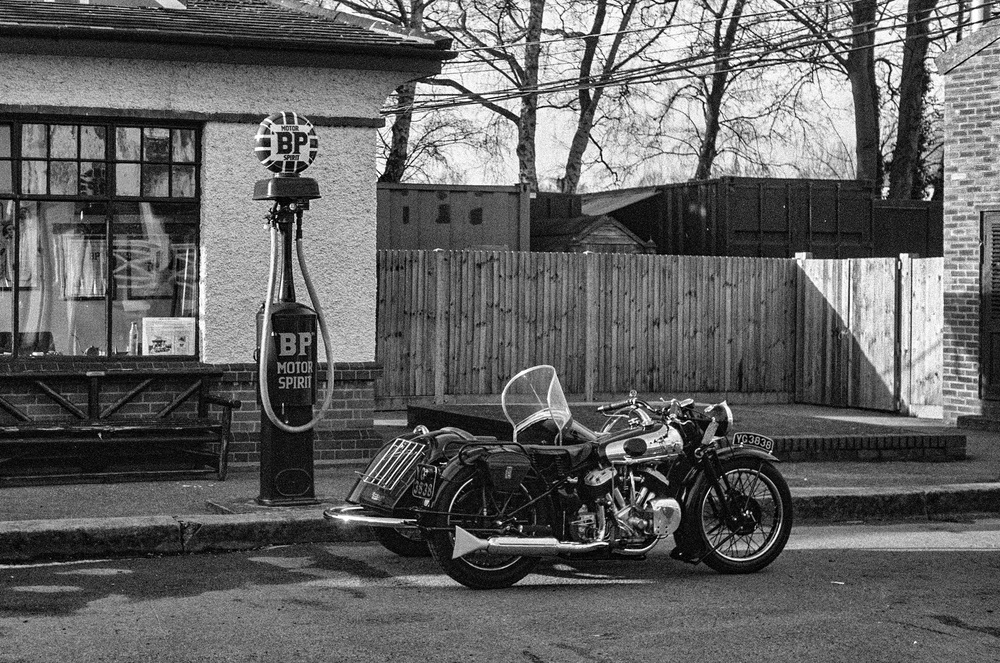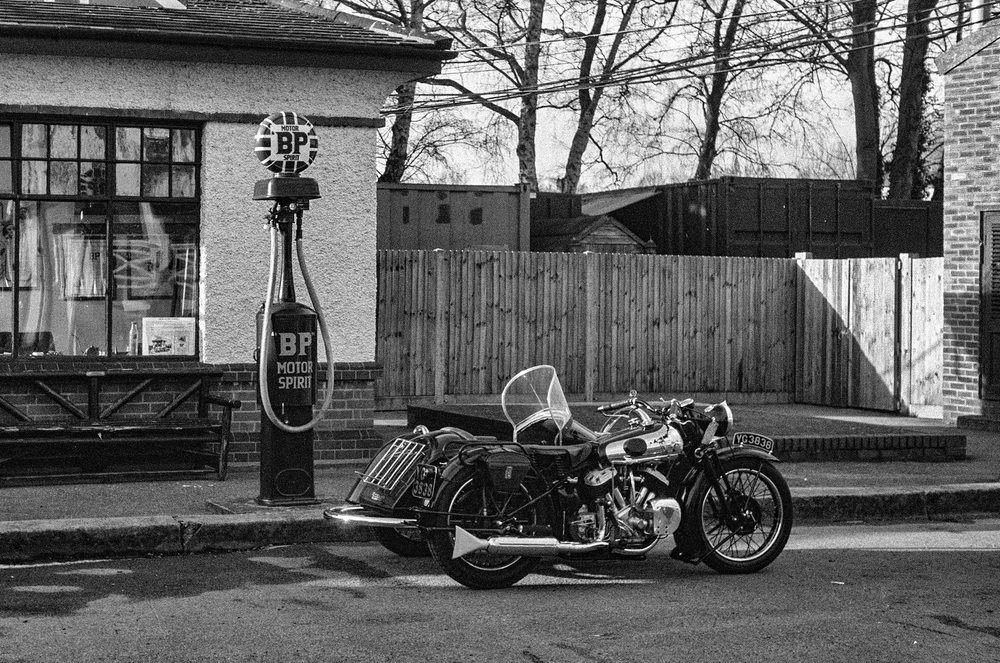
For those of us practiced in traditional silver halide photography, it’s obvious that b&w images (are there really any other kind?) made with film are different than digital b&w. Run your RAW files through any b&w film emulation program you desire and, at bottom, they come out looking different than a native black and white negative. It’s true: silver halide film is capable of certain aesthetic qualities that digital capture simply cannot match. It may be subtle at times, but it’s there, and unlike what some think, It’s not just film grain or lack thereof that constitutes the difference. – Leicaphilia
After spending most of my working life with film I was converted to digital in the early days and didn’t give film another thought until a couple of years ago. I then noticed more and more people carrying around film cameras and seemingly coping well with all the hassles of processing that digital had promised to free us from. Why, I wondered.
At the same time I began to take an interest in Leica film cameras. I had never had one in the old days but had tried almost every other manufacturer. Leica caught my attention, thanks to my interest in Leica digital, and before long I was wandering the streets with a film camera in my hands. I love black and white, for starters, and isn’t an old Leica the first full-frame Monochrom?
Despite all this, I haven’t given much constructive thought to the differences between real film and emulated film processed in Lightroom, Silver Efex Pro or similar. Leicaphilia has gone to a great deal of trouble explaining precisely that: Why digital monochrome images are different to the real McCoy.
- Subscribe to Macfilos for free updates on articles as they are published. Read more here
- Want to make a comment on this article but having problems? Please read this


Nice article, but when it says this:
‘digital’s linear response to highlights is more apt to record bright highlights as pure white, devoid of detail, what we call “clipping” of the highlights, while at the same time giving more shadow detail and thus less deep blacks.’
Isn’t the obvious answer to expose for the highlights? Yes, the sensor response is still linear, but it will get closer to what the Leicaphilia author describes as being characteristic of film (especially after tweaking the curves – C shaped rather than S shaped?)
I think you have a good point here.
It is not the evolution of language that matters; it is the implication behind it. If we lose the links to our past, there is very little left worth keeping. Moore’s Law continues to cause further accelerations with every month that passes. Cameras that are 3 years old are regarded as ‘ancient’. ‘That is so yesterday’ has replaced ‘that is so last year’. When my daughters were young and very much into the current ‘pop culture’ I often told them that what was ‘most up to date’ today would be most ‘out of date’ tomorrow. Now that they are grown up, they fully understand what I was talking about. I am not against the evolution of language but why invent new terms for things that are already described adequately. Some might argue that the purpose of the evolution is to explain things to the ‘digital natives’ but the ‘millenials’ are bright enough to understand that the world existed before digital items came along. That should be part of their learning curve to go alongside our learning curve as ‘digital immigrants’. That way the different generations can understand one another.
William
Hmmmm…
One day William, as I hinted in my initial comment… the digital method will become so good that it will perfectly mimic the analogue.
I am not sure whether that means trouble… or nirvana.
Just a thought.
Thanks Stephen
My reaction is not related to scientific accuracy or anything like that, but to the ‘digi-babble’ that has invaded the world over the past twenty years. This assumes that digital is the norm and terms are used to describe anything that is ‘not digital’ . Examples would include ‘analogue’ to describe photography that is ‘not digital’, ‘mirrorless’ to describe cameras that are ‘not SLRs’, ‘cropped frame’ to describe cameras that are not producing an image the same size as 35mm film and ‘full frame’ to describe cameras which produce a 35mm size image. We did not use such terms at all before digital and its associated ‘digi-speak’, or ‘babble’ as I call it, came along. I somehow doubt that if you were asked tomorrow by a stranger in London about what kind of camera your M2 was, that you would reply by saying that it was an ‘analogue, full frame, mirrorless camera’. You would most likely say that it was a ‘film rangefinder camera’ which would be just as accurate and would avoid using ‘digi-babble’.
Please don’t assume that I am against digital photography. I bought my first digital camera in 1997. Between mid 2004 and early 2011 all of my photography was digital (I was living in the Middle East for most of that time and film processing was neither convenient or often even possible). Even today, I would say that, at most, 20% of my photography is on film.
Picture No 5 is, in fact, the oldest photo in the article and it was taken in 2007 with a Nikon D2Xs. I cannot remember what lens I used.
William
I agree and furthermore I’m sick and tired of everyone using the term "car". It’s was a horseless-carriage then and it still is. How dare we let language evolve? Darn whippersnappers.
Up with this I will not put.
The article in Leicaphilia gives some very good reasons why film photography is different to digital photography. I hesitate to say ‘better’ as that is a matter of taste. We are all conditioned by our upbringing and our past. That is why sometimes we prefer music, as we heard it first, on vinyl LPs or 45s or even 78s many years ago to what is produced on CDs and digital downloads and streams. I cannot explain the recent fad for vinyl LPs among young people but maybe they hear something that is absent in the digital world.
One of my pet hates is people calling film photography ‘analogue photography’. It never was that while I was young. I recently had the pleasure of scanning some slides of my daughters and family holidays which were taken over 30 years ago. They had an indefinable quality which is wholly absent from today’s high IQ digital images. The company that has come closest to recreating the ‘film experience’ is Fujifilm, which is not surprising given the company’s film past. In my recent article on this site about the West of Ireland, photo No 12 of Achill Sound is a perfect example of what I am saying here. It was taken on a Fujifilm X-Pro 2 with a Leica 24mm Elmar lens ( 36mm in ‘real money’) The photo may not be the most dramatic one in this set, but it captures the subtle colours and tones and different shades of light to found in that part of the world just perfectly. This is as near as I have seen to a ‘film look’ in the digital world. It still does not get close to landscapes I took on Fujichrome slide film about 30 years ago.
William
I know what you mean regarding the use of the phrase ‘analogue photography’ William… Erwin Puts has much to say on whether recording images via a digital sensor is actually photography at all.
However, the system to which you refer is pretty much the definition of an analogue method, and it is definitely photography, so I fail to see how you can dislike something that to all intents and purposes is an accurate phrase. It is perhaps ‘digital photography’ that is wrong…
When it comes down to it, people are only really using the two different terms as a simple method of differentiating.
In reference to your piece on the west of Ireland, was ‘Photo 5: Clew Bay from Mulranny’ taken with the Fuji X-Pro 2 and a Leica lens?
William Fagan makes a very good point in your last piece Mike in regard to scanners… What one effectively achieves by scanning a film negative, is a digital image!
However I would venture to call him and raise the stakes slightly in that with film, one still has the negative, indeed there are some negatives that are 150 years old.
The use of scanning is more of a practical alternative to the employment of a darkroom and the production of contact sheets and the occasional enlargement… It would be unfeasible to enlarge as many negatives as a scanner produces digital images.
A point that I made to Adam was that I am currently in the process of mounting and framing a fibre print that Dave Champion has made for me from my original negative… So far from all of the output from my OCOLOY, the only one that I felt the need to have made…
As a side note, I was reading an old piece by The.me yesterday that introduced a computer program from MIT http://memorability.csail.mit.edu/demo.html that can fairly accurately discern what is a memorable image and what is merely of medium or low interest, and my print above came up as of "medium" interest, whilst another that I found not that interesting was perceived as highly memorable… As they might say in the USA… Go figure!
Leicaphilia sort of nails it though when he ends the piece that you highlight Mike…
"The information needed for nuanced highlights is either there to begin with (film), or it isn’t (digital), and no amount of post-process tweaking can add highlight details when highlights have been “blown” or “clipped” i.e. are recorded as pure white."
My feeling is that although digital is more expensive and perhaps not as expressive as analogue…
It is more convenient… The only equipment that one really needs is a camera…
As the man with the DSLR at that Fuji/Leica meeting the other Sunday demonstrated (Forgive me I don’t remember his name)… He doesn’t have a mobile phone and he doesn’t have a home computer… He just goes to Boots/Jessops and prints out the contents of his SD card… No post processing, living by his wits, so to speak!
Maybe in the future, digital will fully eclipse film, but that is another story. Certainly many folk reckon that the Leica Monochrome cameras eclipse any of their other digital cameras, could its wider bandwidth and resulting greater dynamic range give the clue?
In the meantime, perhaps it is film for artistic endeavour, and digital for snapshottery…?
What do you and others think Mike?
I’m staying out of this one. I’ve never developed a film in my life and I have no inclination to try. Film is a sideline for me, but Adam Lee’s enthusiasm is certainly infectious.